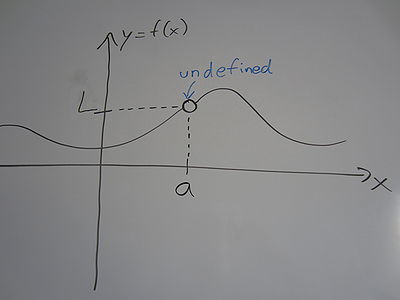Science:Math Exam Resources/Courses/MATH104/December 2013/Question 01 (l)
{{#incat:MER QGQ flag|{{#incat:MER QGH flag|{{#incat:MER QGS flag|}}}}}}
• Q1 (a) • Q1 (b) • Q1 (c) • Q1 (d) • Q1 (e) • Q1 (f) • Q1 (g) • Q1 (h) • Q1 (i) • Q1 (j) • Q1 (k) • Q1 (l) • Q1 (m) • Q1 (n) • Q2 (a) • Q2 (b) • Q2 (c) • Q2 (d) • Q2 (e) • Q2 (f) • Q2 (g) • Q3 • Q4 • Q5 • Q6 (a) • Q6 (b) • Q6 (c) •
Question 01 (l) |
|---|
|
If , where is a real number, which of the following must be true? (A) exists. (B) is continuous at (C) is defined at (D) (E) None of the above. |
|
Make sure you understand the problem fully: What is the question asking you to do? Are there specific conditions or constraints that you should take note of? How will you know if your answer is correct from your work only? Can you rephrase the question in your own words in a way that makes sense to you? |
|
If you are stuck, check the hint below. Consider it for a while. Does it give you a new idea on how to approach the problem? If so, try it! |
Hint |
|---|
|
Remember that limits only tell you information about the values of the function near the value at . In a vacuum, limits don't say anything about the actual value at . |
|
Checking a solution serves two purposes: helping you if, after having used the hint, you still are stuck on the problem; or if you have solved the problem and would like to check your work.
|
Solution |
|---|
|
None of these have to be true! The fact that the limit exists does not imply anything about the value at that point. In fact, need not even be defined at . However, if is not defined at (C), then writing does not make sense because this value does not exist (D). can not be continuous at a point where it's not defined (B), and a function can only be differentiable at those points where it is defined and continuous (A). Therefore, the following is a counter example Hence, the correct answer is (E). |
{{#incat:MER CT flag||
}}









